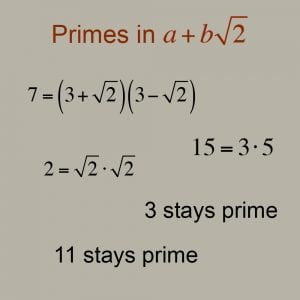
Every integer can be represented uniquely as a product of primes (Source Krishan Canzius).
On April 27, Professor Melanie Wood from the University of Wisconsin-Madison gave a lecture at Dartmouth. The talk was titled “The Chemistry of Primes” and focused on prime numbers in different number systems. The lecture mostly consisted of a review of old work on the subject, but Wood concluded with a brief introduction to her original research.
Primes are essential to number theory, the study of integers, because every integer can be represented uniquely as a product of primes. So they are, in that way, the building blocks of the integers. Primes are defined roughly as positive integers that are only divisible by one and themselves. However, the concept of prime-ness can be extended to systems of numbers larger than the integers.
These systems of numbers are called extensions of the integers. An example of such an extension is the set of numbers of the form a + b √2 where a and b are integers. The regular integers are closed under addition and multiplication: that is, the result of adding or multiplying two integers will itself be another integer. So this extension is essentially the result of pretending that √2 is an integer and allowing the same operations. Examples of numbers in this system would include 1, 3 + 2√2, and 5√2 . Systems of this sort also have their own primes, which are defined in essentially the same way as prime numbers are defined in the integers: numbers that aren’t divisible by anything in the system except themselves and units (numbers which have properties similar to one in the system).
Numbers that are prime in the integers may or may not be prime when considered as elements of an extension. For example, two is normally a prime number, but in the extension a + b √2 it is not since 2 = √2 * √2 (√2 is one of the allowed numbers in this extension); however, 3 remains prime. One might ask about the proportion of primes that have each of these behaviors in a given extension. This is a question that can be answered using theorems of Gauss and Dirichlet: for a fixed extension, a random prime has a 50% probability of factoring, and a 50% probability of remaining prime.
One might also ask the related question: given a fixed prime, what are the probabilities of it splitting, being inert, or ramifying in a random extension? This question may seem to be the same as the preceding one, but the two are very different. The difference can be illustrated through an example: knowing that it is going rain for 30% of the world tomorrow is very different than knowing that there is a 30% chance of rain at one’s current location. This second question is much more difficult than the original and is the focus of Wood’s current research. In fact, the probabilities will be different depending on the way in which one choses to order the extensions!